1 Introduction to porridge
Se porridge is a traditional dish of Ha Mo commune, Dan Phuong district, Hanoi city. This porridge is very special, completely different from the usual porridge. If you have the opportunity to travel to Hanoi, visit Ha Mo village, you definitely cannot miss this unique and equally attractive dish.
Porridge is usually made from rice or rice flour, but porridge is made from ground rice and then rolled into long strands. At first glance, this porridge looks quite similar to the banh canh of the Central and Southern regions. However, the difference is that the strands are rolled from rice flour and completely by hand, so they are very soft and delicious. The porridge is topped with meat, sesame and spices to taste. If you have the chance to enjoy porridge once, you will definitely remember it forever.
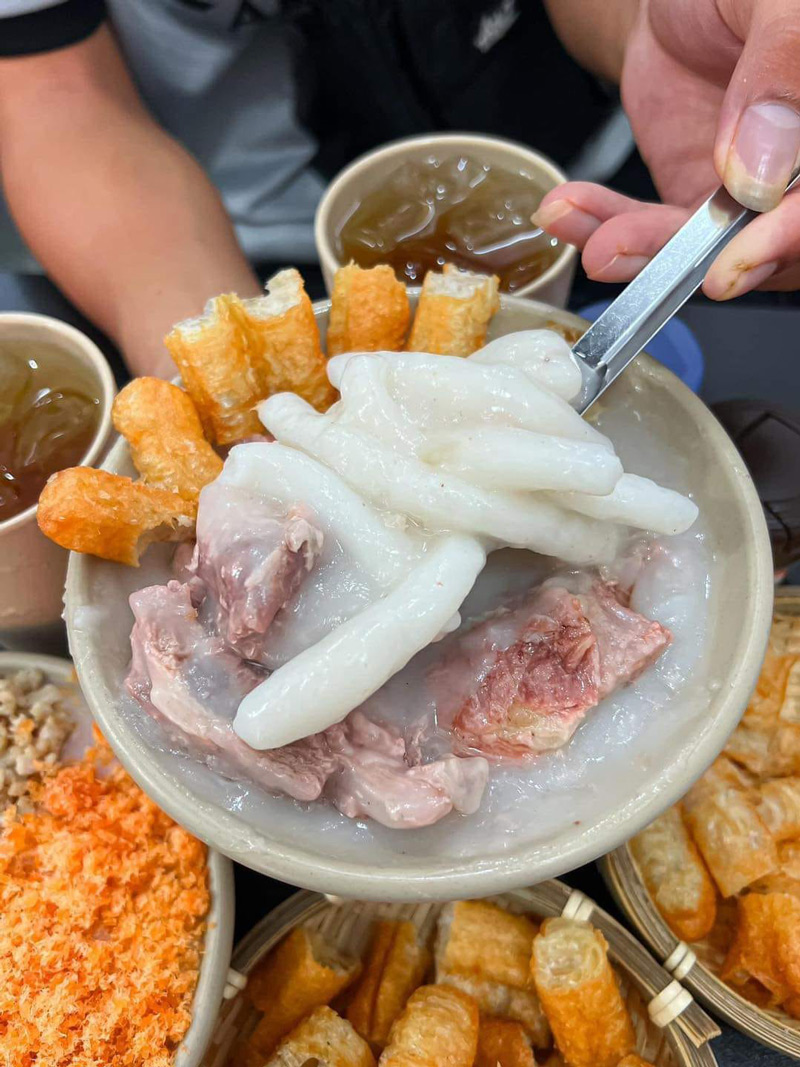
Se porridge is a unique dish with rice flour strands rolled into large strands. Photo: Se Porridge Artisan Punnata
2 Origin of porridge
According to Vietnamtravelio, in historical documents, the ancient land of Ha Mo was once O Dien, also known as Ke O. This is where O Dien citadel is located, which marked the nation’s history when it became the capital of the Van Xuan state under the reign of Hau Ly Nam De in the 6th century.
According to legend, the porridge dish in Ha Mo village has existed for hundreds of years, associated with the story of rewarding the army. Legend has it that every time he returned from a victory, Prince Ly Bat Lang often slaughtered a pig to treat his army. The pork was divided among the generals, and the bones were boiled into soup for the soldiers to eat with rice. During a visit to the army, seeing that they were lacking food, the Prince ordered his courtiers to prepare a new dish from pork bones and available ingredients to reward his army.
The courtier created the porridge by grinding rice into a fine powder, then kneading it with warm water to create a dough with the right consistency. Next, he used his hands to roll the dough into small strands and dropped them into a pot of boiling bone broth.
When the flour is dropped into the pot of bone broth, it forms long strands that resemble small loach lobes wrapped around the chopped pork bones. The meat that is still stuck to the pork bones when simmered also breaks into small strands, making the dish more attractive. Finally, a little flour is mixed with water and added to the pot to create a smooth consistency for the porridge, making the dish look attractive and delicious.
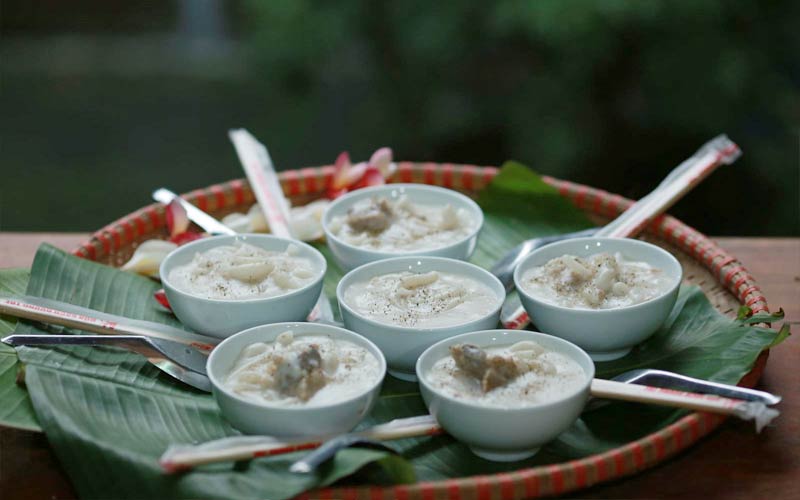
This dish originated from the Van Xuan period, under the reign of Hau Ly Nam De in the 6th century. Photo: 2dep
When the courtier offered the dish to the king, Prince Ly Bat Lang personally tasted it and commented that: The rice noodles were chewy, the core was just crispy enough, mixed with the sweetness of the meat, the fat of the bone broth. Along with that, the soft meat noodles resembled the image of soldiers surrounding the bones like generals, all creating a unique and very meaningful dish.
From then on, the porridge dish was born. Prince Ly Bat Lang ordered that the army must have this porridge every time they celebrated their troops and it also became his favorite dish. On August 12, Tan Mao year – 571, after leading his army to victory in battle and returning to O Dien citadel, during the feast to celebrate his troops, the Prince transformed himself at the palace camp in Ha Mo village in a black cloud.
The local people built a temple to worship the Prince under the order of the Later Ly Nam De Ly Phat Tu, and later dynasties all issued royal decrees to honor him. Since then, on January 12 every year, Ha Mo village holds a traditional festival to celebrate the birthday of the Thanh Hoang and the death anniversary of Prince Ly Bat Lang.
In the traditional festival of the village, the indispensable dish to offer to the village guardian spirit is “Chao se khao quan”. To commemorate a glorious period when O Dien was the capital of Van Xuan state, the local people called this dish “Van Xuan” porridge.
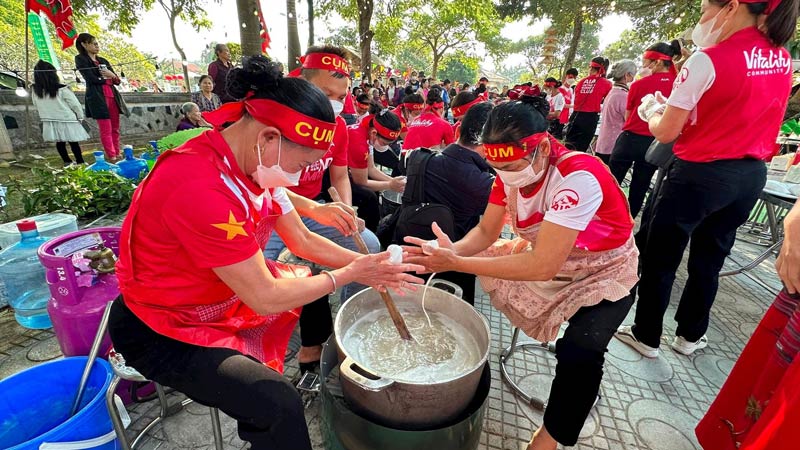
The Ha Mo commune porridge cooking festival was held to commemorate the death anniversary of Prince Ly Bat Lang. Photo: nguoihanoi
3 Ingredients and how to make porridge
The typical porridge of Ha Mo village has the main ingredients of finely ground rice and bone broth, accompanied by a little minced meat stir-fried with fragrant fried onions. Although the ingredients are simple, the processing requires skill, meticulousness and sophistication. Ha Mo people often use ground rice to make a watery powder, then put the powder in a cloth bag and hang it up to let the water drain. This process helps create a soft, elastic, evenly colored, smooth, and pure white dough.
The broth of the porridge is simmered from bones for many hours, in addition to adding pig tail bones for a more delicious and clear taste. Bone broth plays an important role in this porridge, not only providing natural sweetness but also nutrition. When simmering the bones, the cook needs to pay attention to removing the foam to keep the broth clear, ensuring delicious flavor and color without being cloudy.
Once the broth is boiling, the stove will be adjusted to low heat and the dough will be rolled into small strands the size of the palm of the hand, similar in size to the tip of a chopstick, then dropped into the pot of bone broth.
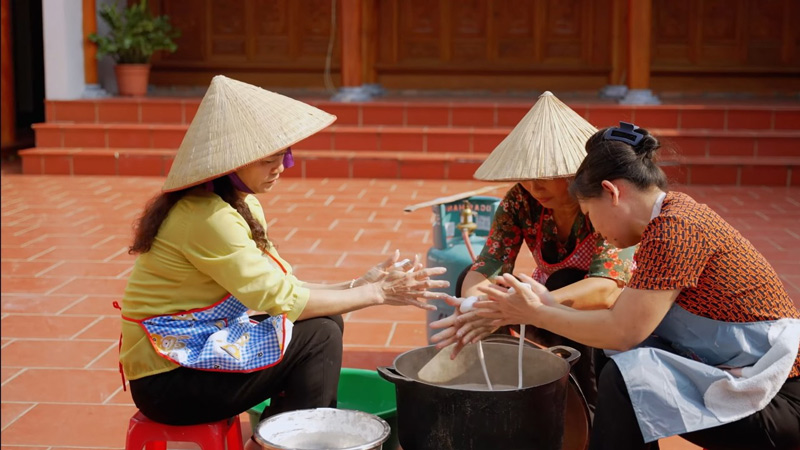
The step of rolling rice flour into threads takes the most time. Photo: dulich.laodong
The most difficult step in the process of cooking porridge is stirring constantly so that the noodles do not break or clump together but still blend together in the pot of bone broth. To increase the smoothness of the broth, the cook can add a little tapioca starch or sticky rice flour to the pot. Porridge is best cooked in a cast iron pot on a wood stove with moderate heat so that the porridge does not burn.
When the porridge is cooked, the color will turn clear white, with no more flour inside. At this point, the cook will add the stir-fried lean meat to the pot and season to taste. To enhance the flavor, some people also sprinkle green onions, pepper or roasted peanuts on the porridge bowl.
This porridge dish is especially delicious when enjoyed on cold winter days with each soft and chewy strand of porridge, the sweetness of the bone broth and the fatty taste of peanuts and sesame. All of these flavors blend together to create a warm culinary experience, imbued with the rustic character of Hanoi people.
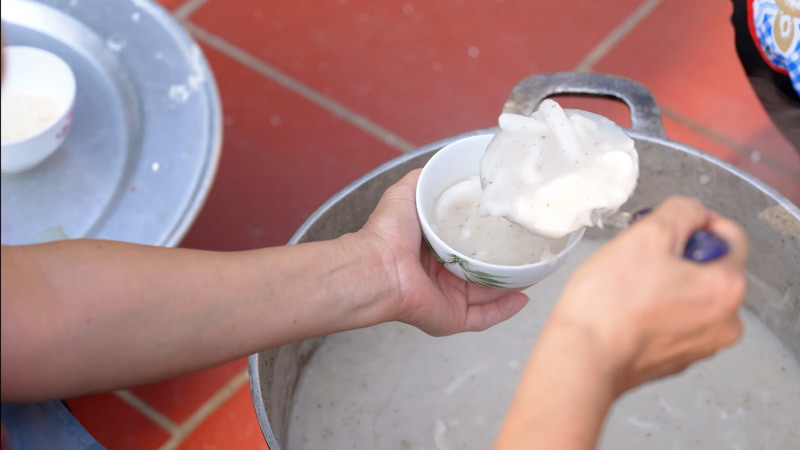
The finished product will be soft and tough fibers. Photo: dulich.laodong
4 Address to enjoy porridge
Currently in Hanoi, porridge is not a very popular dish. To enjoy this dish, you can go to Ha Mo village, Dan Phuong district. There are many popular porridge shops with the most authentic flavor for you to choose from. However, because this commune is in the suburbs, the distance is quite far.
Besides, you can also visit some of the porridge shops below, which are close to the center and also more convenient to travel:
Se Porridge & Drinks – 15A Hang Tre
Address: 15A Hang Tre, Ly Thai To Ward, Hoan Kiem District, Hanoi
Punnata Artisan Porridge
Facility 1: 70 Thai Ha, Trung Liet Ward, Dong Da District, Hanoi
Facility 2: 66 Chua Lang, Lang Thuong Street, Dong Da District, Hanoi
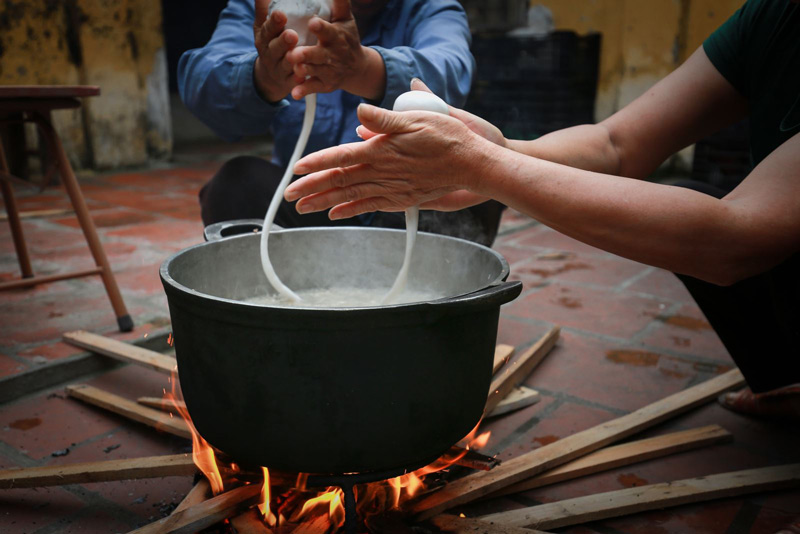
The meticulousness when cooking porridge of Hanoi people. Photo: dailycall
Se porridge is a very special dish of Hanoi cuisine. Not only is it simply a delicious dish, se porridge is also associated with the tradition of patriotism and the indomitable spirit of our ancestors. Hopefully, with the information from the Vietnamtravelio travel guide, you have another delicious dish that cannot be missed when you have the opportunity to visit the land of the thousand-year-old capital.
